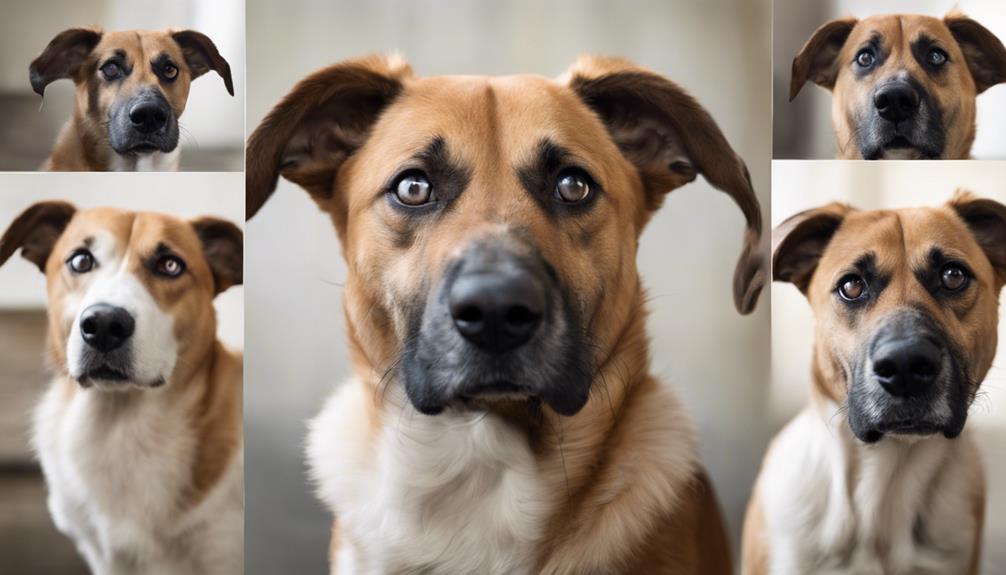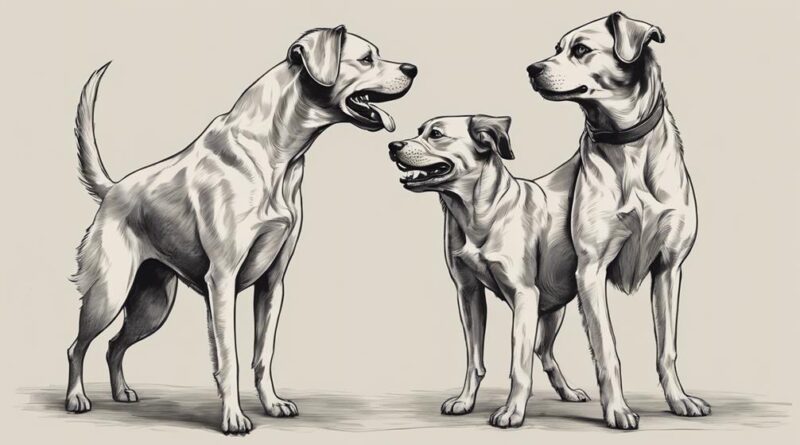What Role Do Facial Expressions Play in Dog Communication?
Have you ever considered the sheer magnitude of information conveyed through a dog's facial expressions?
From subtle shifts to overt signals, a dog's face is a canvas of communication. Understanding these cues is crucial for deciphering your furry companion's emotions and intentions.
Imagine the impact of misinterpreting a playful grin as a sign of aggression or overlooking a fear-induced lip lick.
Stay tuned to unravel the intricate world of dog communication through facial expressions.
Canine Facial Expressions Overview
When observing dogs, pay attention to their facial expressions to understand their emotions and intentions. Canine emotion recognition is crucial for interpreting what your furry friend is trying to communicate. Dogs rely heavily on nonverbal communication cues, with their faces being a significant part of this interaction.
A dog's facial expressions can convey a wide range of emotions, from joy and excitement to fear and anxiety. Understanding these cues will help you build a stronger bond with your pet and ensure their well-being. For example, a relaxed and slightly open mouth, along with soft eyes, usually indicates a happy and content dog. On the other hand, a wrinkled forehead, narrowed eyes, and bared teeth may signal aggression or discomfort.
Understanding Dog Facial Cues
Pay close attention to the subtle changes in your dog's facial expressions as they're key indicators of their emotions and intentions. Dogs use their facial cues as communication tools to express a wide range of emotions and convey important messages to their human companions. Understanding these communication cues is vital in building a strong bond with your furry friend.
Facial cues such as relaxed eyes, a soft mouth, and gently wagging tail are often signs of contentment and relaxation. On the other hand, a furrowed brow, narrowed eyes, or bared teeth may indicate fear, anxiety, or aggression. By paying attention to these emotional expressions, you can better interpret your dog's state of mind and respond accordingly.
It's essential to remember that each dog is unique, and their facial expressions may vary based on their breed, personality, and past experiences. By observing and learning your dog's specific facial cues, you can deepen your understanding of their emotions and strengthen your bond through effective communication.
Joy and Happiness Signals
To recognize joy and happiness in your dog, observe their bright eyes and relaxed mouth, which are common signals of positive emotions. When your dog is content and happy, you may notice various contentment signals and relaxation cues that indicate their overall well-being.
Here are some affectionate expressions and bonding behaviors you might see:
- Tail Wagging: A wagging tail is often a clear sign of joy and excitement in dogs.
- Playfulness: Dogs will exhibit playful behaviors when they're feeling happy and content.
- Cuddling: Seeking physical closeness and cuddling with you or other family members shows their affectionate nature.
- Smiling: Dogs often 'smile' by showing their teeth in a relaxed manner when they're feeling joyful and relaxed.
Fear and Anxiety Expressions
In your dog's communication, expressions of fear and anxiety can be subtle yet crucial indicators of their emotional state. When your dog is experiencing fear, they may exhibit various fear signals such as cowering, trembling, or trying to hide. You might notice their ears pinned back, tail tucked between their legs, or dilated pupils. These fear expressions communicate a sense of unease or apprehension that your dog is feeling in that moment.
Similarly, your dog might display anxiety cues when they feel stressed or worried. These anxiety cues could include lip licking, yawning, or pacing. Your dog may also show signs of restlessness, excessive panting, or seeking comfort from their owner. Understanding these anxiety expressions can help you address the underlying causes of your dog's distress and provide them with the support they need to feel more secure and at ease in their environment.
Aggression and Warning Signs
You may notice subtle changes in your dog's body language and demeanor that signal the onset of aggression and serve as warning signs in their communication. Paying attention to these aggression signals and warning cues can help you better understand your dog's state of mind and potentially prevent any aggressive behavior.
Here are some key indicators to watch out for:
- Raised Fur: When your dog's fur stands on end, especially along the back and neck, it could indicate that they're feeling threatened or aggressive.
- Growling or Snarling: Audible signs like growling or snarling are clear warnings that your dog isn't comfortable with the current situation.
- Stiff Body Posture: A rigid and stiff body, with tense muscles, suggests that your dog is on high alert and may be ready to act aggressively.
- Direct Eye Contact: Intense and unwavering eye contact, often accompanied by a fixed stare, can be a sign of impending aggression in dogs.
Playfulness and Excitement Indicators
When observing your dog's playfulness and excitement indicators, watch for their tail wagging rhythmically and their body language appearing loose and relaxed. These cues often signal your furry friend's joyful mood.
You may notice your dog engaging in puppy antics, such as playful bounces or zooming around with enthusiasm. Energetic greetings, like spinning in circles or bringing you toys, are common signs of their excitement.
Additionally, tail wagging is a classic indicator of a happy and playful dog. A wagging tail accompanied by alert postures, like a slightly lowered front end and a raised hind end, shows that your dog is ready and eager to play.
Their body language will likely be relaxed, with a wagging tail, open mouth, and possibly some playful barking or vocalizations. Understanding these playful cues can deepen your bond and enhance communication with your four-legged companion.
Submissive and Appeasement Gestures

To understand your dog's submissive and appeasement gestures, pay attention to their body language and facial expressions for cues indicating a desire to avoid conflict or show deference. When observing these behaviors, keep in mind the importance of social hierarchy in canine interactions. Here are some key points to help you recognize calming signals and appeasement gestures in your furry friend:
- Body Position: Your dog may lower their body closer to the ground, tucking in their tail and flattening their ears against their head.
- Avoiding Eye Contact: Dogs exhibiting submissive behavior may avert their gaze or look away from a dominant dog or person.
- Lip Licking: Excessive lip licking can be a sign of stress or an attempt to appease a more assertive individual.
- Turning Away: Your dog might turn their body or head to the side, showing their profile instead of facing head-on.
Understanding these subtle cues can enhance your bond with your pet and help prevent misunderstandings in your interactions.
Communication Breakdowns and Misinterpretations
In dog communication, misunderstandings can arise due to breakdowns in signals and misinterpretations of subtle cues. Dogs rely heavily on body language and facial expressions to convey their feelings and intentions, but these signals can sometimes be misunderstood by humans or even other dogs.
For example, a wagging tail is often associated with happiness, but it can also indicate anxiety or tension depending on the context. These misunderstood signals can lead to communication barriers between dogs and their human companions, potentially causing confusion or conflicts.
Additionally, misinterpretations of a dog's facial expressions can further complicate communication. A dog may show signs of discomfort through subtle cues like lip licking or yawning, which can be easily missed or misinterpreted as a sign of relaxation. Failure to recognize these signals can result in the dog feeling stressed or anxious without their needs being addressed.
Therefore, it's crucial for dog owners to educate themselves on canine body language and facial expressions to prevent misunderstandings and overcome communication barriers for a healthier and happier relationship with their furry friends.
Frequently Asked Questions
Can Dogs Fake Their Facial Expressions to Manipulate Humans?
Dogs can indeed fake their facial expressions to manipulate humans. Canine deception is a real thing, and they're quite skilled at emotional manipulation through their expressions.
While most of their facial expressions are authentic and serve to communicate with humans, there are instances where dogs may exaggerate or alter their expressions to get what they want from their human companions. This behavior adds complexity to the human-animal bond.
Do Different Dog Breeds Have Unique Facial Expressions?
Different dog breeds do indeed have unique facial expressions. These differences can be subtle but play a significant role in communication cues. Understanding these variations is essential for interpreting canine behavior accurately.
From the alert ears of a German Shepherd to the playful grin of a Labrador Retriever, each breed showcases distinct facial expressions that reflect their personalities and intentions. Paying attention to these cues can deepen your bond with your furry friend.
How Can I Train My Dog to Better Understand Human Facial Expressions?
To help your dog understand human facial expressions, focus on body language and training techniques. Use positive reinforcement when your dog responds correctly to your facial cues.
Start with simple commands like 'sit' and reward them when they follow your expressions. Over time, your canine friend will learn to associate your facial expressions with specific emotions or commands, improving communication between you both.
Are There Any Medical Conditions That Can Affect a Dog's Facial Expressions?
Medical conditions can impact a dog's facial expressions. Canine Bell's Palsy or facial paralysis can affect their ability to move facial muscles. Cranial nerve disorders can also cause changes in their facial expressions. These conditions might make it challenging for your furry friend to convey emotions through facial cues.
If you notice any unusual changes in your dog's facial expressions, it's essential to consult a veterinarian for proper diagnosis and treatment.
Do Dogs Use Facial Expressions Differently When Communicating With Other Animals Versus Humans?
When dogs communicate with other animals, they may use different facial expressions compared to when they interact with humans. Across species, dogs rely on nonverbal cues like body language to convey their emotions and intentions.
Canine social interactions involve a complex interplay of facial expressions and gestures that can vary depending on the recipient. Understanding these subtle signals can help you interpret your dog's emotions more accurately in different social settings.
Conclusion
In conclusion, facial expressions are a vital aspect of dog communication. Understanding the various cues and signals that dogs use can help improve our interactions with them and strengthen our bond.
Whether it's a joyful grin, a fearful look, or a playful wag of the tail, paying attention to their expressions can help us better understand their emotions and needs.
So next time you see your furry friend, take a moment to observe their facial expressions and communicate effectively.
